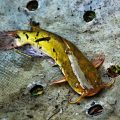Channel Catfish are popular recreational fish that are managed through creel and size limitations set by state recreational fishing rules. The most important species of aquatic animal commercially produced in the United States is the channel catfish, Ictalurus punctatus (Rafinesque). It is a member of the order Siluriformes and the family Ictaluridae. The channel catfish has been described as having a swimming tongue. They have taste buds across their bodies, with the majority concentrated around their gills and whiskers.
Channel catfish were previously found only in the Gulf States and the Mississippi Valley, north to Canada and Mexico’s prairie provinces, but not on the Atlantic coastal plain or west of the Rocky Mountains. Channel catfish have since been widely spread throughout the United States and around the world. The blue cat, willow cat, chucklehead cat, and spotted cat are all names for the Channel catfish (Ictalurus punctatus).

Channel Fish Stats
| Order: | Siluriformes |
| Scientific Name | Ictalurus punctatus |
| Class | Actinopterygii |
| Family | Ictaluridae |
| Genus | Ictalurus |
| Species | I. punctatus |
Physical Characteristics
Channel catfish are distinguished by grayish-blue sides, a black back, and a white belly. Though rare in the wild, channel catfish can have recessive genes that cause albinism or a lack of pigmentation. The albino channel catfish is peach in color. Domestic channel catfish with recessive albino alleles have been developed, and these fish are popular in aquariums and decorative ponds.
Size
A mature channel catfish weighs two to four pounds and measures at least 12 inches (30 centimeters) in length. A 58-pound (26.3-kilogram) channel catfish taken in South Carolina in 1964 set the world record.
Native Environment
The most prevalent species of catfish in North America is channel catfish. Channel Catfish prefer clean water with warm temps. Anglers can catch channel catfish in nearly everybody of water east of the Rocky Mountains, all the way into Mexico and Canada. Catfish are some of the most underappreciated fish in the country because they grow large, fight well, and taste delicious.
Food and Eating Habits
Channel catfish are bottom-dwelling, opportunistic omnivores with acute senses of smell and taste that they employ to locate food in murky, dark waters. Though taste receptors are found throughout the catfish’s body, the largest concentration is found on the four pairs of barbels (or “whiskers”) that surround the mouth.
The channel catfish at the Smithsonian National Zoo’s Kids’ Farm are fed a floating pellet, but they also eat aquatic insects, algae, and plants that grow naturally in the pond.
Blue Cat vs. Blue Catfish
Despite their common name, channel catfish, are not the same species as blue catfish. “Blue cat” is a common term for channel catfish in some locations, especially during the spring spawning season when the male channel cat turns a dark blue hue.
Channel catfish and blue catfish might be difficult to distinguish. Channel catfish are often brown with darker markings, whereas blue catfish are blue. Catfish, on the other hand, vary in color depending on the water they dwell in, and channel catfish typically lose their spots as they grow larger.
The best way to tell these catfish apart is to count the number of rays on their anal fin. Blue catfish will have more than 30 anal rays, while channel catfish will have fewer than 30. The blue catfish has a squared-off anal fin on the front edge, whereas the channel catfish has a rounder anal fin. The swim bladder of the blue catfish contains three chambers, whereas the channel catfish has two. Blue catfish are the largest species, with an all-tackle record of 143 pounds.
Age and Development
Warm water allows channel catfish to grow more quickly. Water temperatures of around 85 degrees Fahrenheit are ideal for growth. When the temperature changes by 18 degrees, their metabolic rate is always cut in half or doubled. The typical size of channel catfish captured by fishermen in fresh or natural waters is less than two to three pounds. Their size and age in natural waterways are determined by a variety of variables.
According to research and studies on the age and growth of channel catfish, they do not reach 1 pound in many natural glasses of water until they are 2 to 4 years old. According to research conducted in the Lake of the Ozarks, channel fish do not achieve a total length of 13 inches until they are eight years old. This fish has been known to live for as long as forty years.
As a result, the growth rate of channel fish in production ponds is affected by parameters such as food taste, quality and quantity of food provided, water quality, frequency of feeding, and a variety of others. The majority of farm-raised channel catfish are collected at 18 months and 11/4 pounds.
Fishing Advice
Channel catfish prefer baits with strong scents, such as chicken livers and stink baits, like blood baits. They will also consume anything that is native to the area, such as minnows, break, shad, or sunfish. Channel catfish enjoy locations with some structure, such as a bridge, felled tree, dock, or rocks.
When fishing for channel catfish, look for structure and points in the deeper regions of the fishery before moving into the shallow areas. Catfish prefer deeper water during the day and shallower water at night, but this varies depending on the fishery. Knowing the local waters is essential for a good day of catfishing, which is why hiring a local fishing guide is a wonderful alternative when going after catfish.
Bottom-fish with a strong #2 to #4 hook and a big split-shot sinker. The type of tackle you use is determined by the size of the fish you are attempting to catch. A medium action combo with a 15 to 20-pound fishing line is frequently sufficient. Some skilled fishers may utilize a stronger rod and fishing line while pursuing trophy channel catfish. When handling this fish, keep an eye out for sharp spines.
How Does a Channel Catfish Behave?
During the day, they hid in caves, holes, and beneath fallen logs. They are nocturnal because they move energetically at night in quest of food. They do not have a territory and frequently wander across a water system, even though they rest in holes throughout the day.
Do Channel Cats Have Offspring?
Males and females’ mate by swimming together and simultaneously releasing eggs and sperm into a nest created by the female or both the male and female. After mating, the male chases the female away and then defends the eggs until they hatch. In the summer, channel catfish spawn.
Final Remarks
The upper body of an adult channel catfish is blue, olive, grey, or black, with dark patches along the flanks and a white ventral surface. The color appears to be determined by the color of the water in which it lives. It can seem virtually black in clear water but olive to a pale yellowish white in muddy water. Channel catfish have been widely introduced for sport fishing throughout the United States; their huge size and delicious flavor make them a favorite target for anglers.












Pingback: Are Catfish Aggressive Towards Humans? | Reel Fishing Guru
Pingback: How to Bank Fish for Catfish | Reel Fishing Guru
Pingback: What is the Difference between Catfish and White Bass? | Reel Fishing Guru